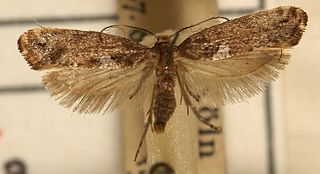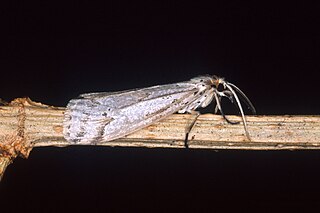
The Acrolepiidae are a family of moths known as false diamondback moths. In modern classifications, they are often treated as a subfamily (Acrolepiinae) of the family Glyphipterigidae.

Acrolepia autumnitella is a species of moth of the family Acrolepiidae. It is found in most parts of Europe. The wingspan ranges from 11 to 13 mm.

Acrolepia is a genus of moths in the family Acrolepiidae.
Rejecta Mathematica was an online journal for publishing papers that had been rejected by other mathematics journals. Each paper was accompanied by an open letter describing why the paper was rejected, how the topic has been developed since and why it is worthy of publication. The first issue was published in July 2009 containing topics such as image enhancement and condition numbers. The quality of the contributions in the first issue was seen as mixed. The editors were Michael Wakin, Christopher Rozell, Mark Davenport and Jason Laska.
Acrolepia aureella is a moth of the family Acrolepiidae. It was described by Blanchard in 1852. It is found in Chile.
Acrolepia marmaropis is a moth of the family Acrolepiidae. It was described by Edward Meyrick in 1919. It is found in South America.
Acrolepia chariphanes is a moth of the family Acrolepiidae. It was described by Edward Meyrick in 1931. It is found in Chile.
Acrolepia halosema is a moth of the family Acrolepiidae. It was described by Edward Meyrick in 1931. It is found in Argentina.
Acrolepia conchitis is a moth of the family Acrolepiidae. It was described by Edward Meyrick in 1913. It is found in India (Assam).
Acrolepia corticosa is a moth of the family Acrolepiidae. It was described by Edward Meyrick in 1913. It is found in Sri Lanka.
Acrolepia oxyglypta is a moth of the family Acrolepiidae. It was described by Edward Meyrick in 1929. It is found in Panama.
Acrolepia niphosperma is a moth of the family Acrolepiidae. It was described by Edward Meyrick in 1931. It is found in Argentina.
Acrolepia cestrella is a moth of the family Acrolepiidae. It was described by August Busck in 1934. It is found on Cuba.
Acrolepia kasyi is a moth of the family Acrolepiidae. It was described by Reinhard Gaedike in 1968. It is found in Afghanistan.
Acrolepia maculella is a moth of the family Acrolepiidae. It was described by Blanchard in 1852. It is found in Chile.
Acrolepia moriuti is a moth of the family Acrolepiidae. It was described by Reinhard Gaedike in 1982. It is found in Japan.
Acrolepia rungsella is a moth of the family Acrolepiidae. It was described by Lucas in 1943. It is found in Morocco.
Acrolepia seraphica is a moth of the family Acrolepiidae. It was described by Meyrick in 1931. It is found in Argentina.
Cyana rejecta is a moth of the family Erebidae. It was described by Francis Walker in 1854. It is found in the Democratic Republic of the Congo, Ethiopia, Kenya, Malawi, Sierra Leone, South Africa, Tanzania, Gambia and Uganda.
Polybia rejecta is a species of social wasp found in the Neotropics region of the world. It was discovered by Fabricius in South America in the 1790s. The wasp is associated with many other organisms, particularly specific species of ants and birds such as the Azteca ants and the cacique birds. This association is most beneficial to the ants and birds because of the aggressive protective nature of the wasp. The wasps will protect their nest even if it means death against any predator that approaches it and therefore this means that the association also protects the ants and birds. Additionally, the wasp is known for eating the eggs of red eyed tree frogs as a main way of subsistence. It also, like many other wasp species, has a caste system of queens and workers that is evident by difference in body size among the wasps; the biggest female becomes the queen.


